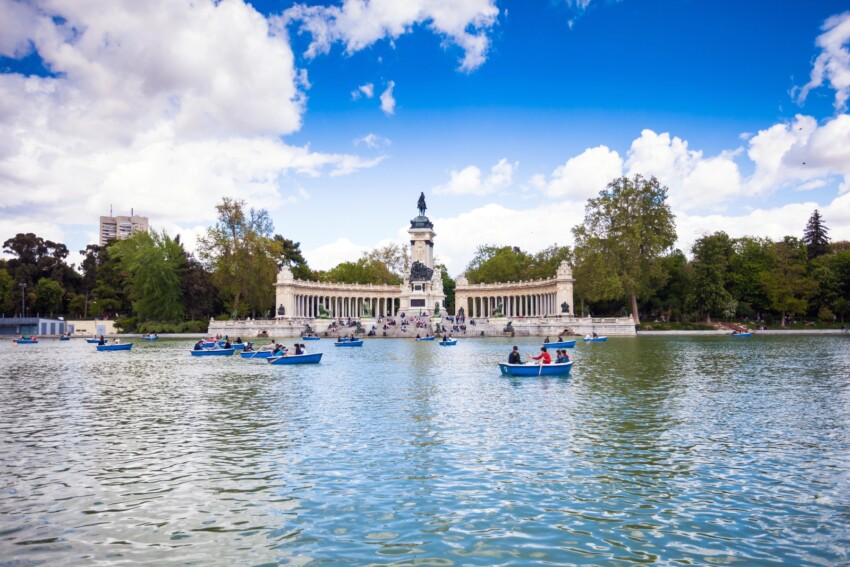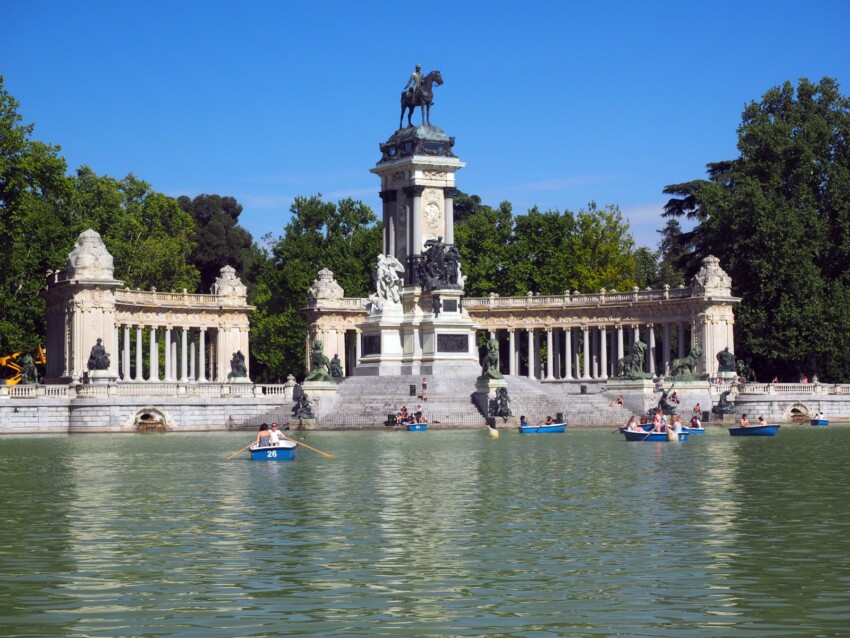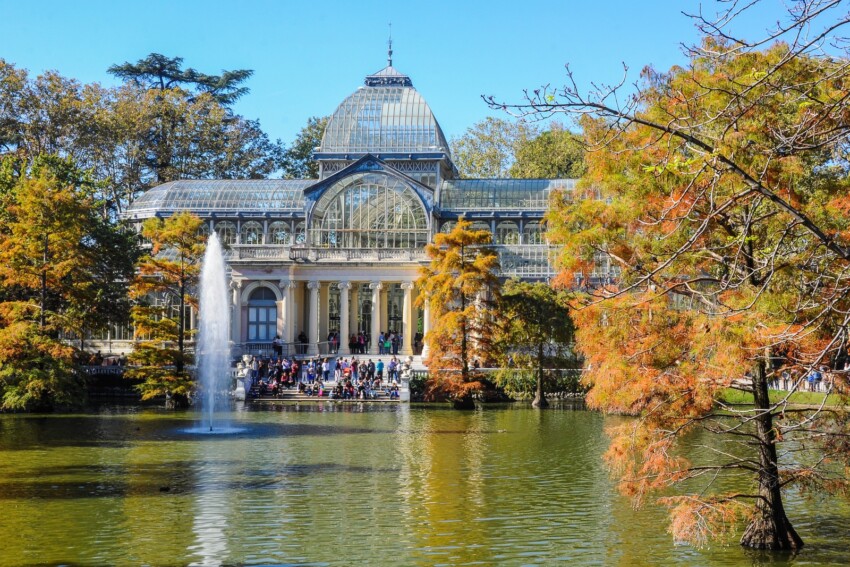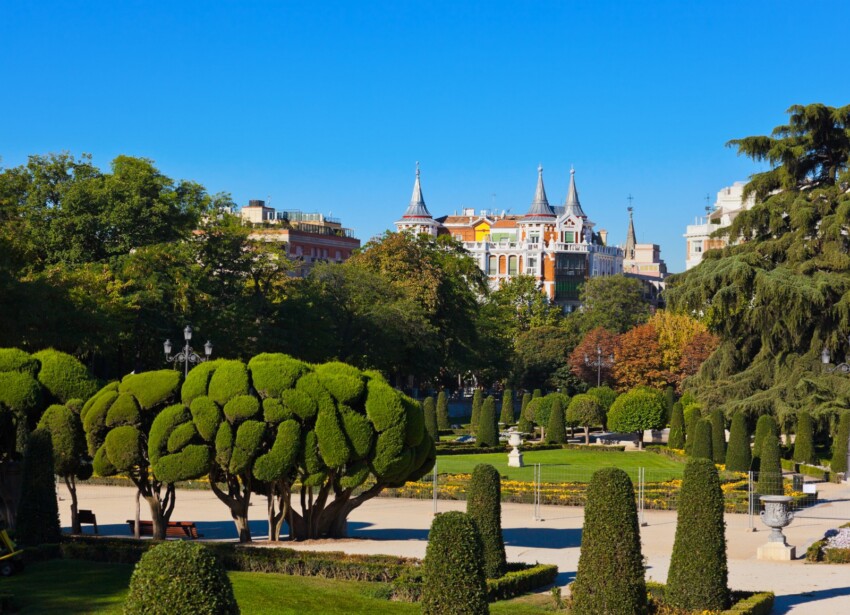

125 hectares, 15,000 trees (including the oldest in the city) and 4,000 roses are the impressive figures of the Retiro Park (also known as Parque del Buen Retiro), Madrileños’ favourite place for a relaxing break.
These figures fail to convey the importance of the Buen Retiro in the daily lives of Madrileños, who from early spring to late summer elect it as their favourite weekend destination.
Come here for a break between cultural visits. You can stroll for hours along its tree-lined boulevards, photograph elegant architectural structures, have a coffee on an outdoor terrace or hire a rowing boat for romantic hours on Spain’s most famous artificial lake.
Ideal for escaping the scorching heat of the Madrid summer, Retiro Park is not only the city’s green lung but also an important cultural centre. From late June to mid-July, its tree-lined avenues fill with book stalls for the tenth annual Book Fair, the city’s most important literary event; other important events are organised throughout the year.
Open all year round from early morning to late evening, the Retiro Park will give you some of the most beautiful hours of your holiday in Madrid.
The name of the park hints at its origins: the Retiro Park was in fact founded in the 17th century by King Felipe IV as a place where the king and his court could ‘retire’ to private life, leaving the official residence in search of a break from court obligations. For centuries a royal property, the park was acquired by the Madrid City Council and opened to the public in 1868. In 1953 it was declared a ‘Garden of High Historical and Artistic Value‘.
The extensive Retiro Park is a riot of elegant buildings and decorative elements. You could spend a whole day in it, stopping to admire all its attractions! Here are the ones not to be missed.

Numerous sculptures, fountains and decorative elements adorn the Retiro Park. The park’s symbolic image, which you will find on all Madrid postcards and guidebooks, is the artificial lake (estanque) dominated on the eastern side by the Monument to Alfonso XII.
It is a grandiose marble colonnade decorated with numerous sculptures; in the centre of the composition stands the bronze statue of the king. 30 metres high, 86 metres long and 58 metres wide, the monumental colonnade seems to embrace the lake and become one with it.
Its steps are a popular meeting place for Madrileños, especially in summer, while the lake’s ponds are ploughed by numerous rowing boats. Rent one yourself: you’ll feel like you’re in Cambridge, but with many degrees more!
The most famous statue in Retiro park is El Ángel Caído, the only statue in the world dedicated to the devil, by Madrid artist Ricardo Bellver y Ramón. A symbol of guilt, a warning not to sin, this angel cast out of paradise silhouetted against Madrid’s blue sky is an image with great dramatic force and an exceptional photographic subject.
Among the fountains, one of the most beautiful is the Fuente de los Galápagos, commissioned in the 19th century by King Ferdinand II to commemorate the birth of his daughter Isabel II. Decorated with allegorical motifs and marine elements recalling longevity and fertility, it was initially located in the Red de San Luis and only later was it moved to the park.

The architectural jewel of the Retiro Park is the Crystal Palace (Palacio de Cristal), an elegant glass and metal construction half-hidden by trees on the southern shores of the lake and one of the best examples of ‘iron architecture’ in Spain. Inspired by Paxton’s Crystal Palace, it was built in 1887 as a greenhouse for tropical plants; today it is used as a venue for exhibitions organised by the Centro de Arte Reina Sofía.
Not far from the Glass Palace is another exhibition space, the Velázquez Palace, a venue for temporary exhibitions designed by the same architect who designed the Glass Palace. This structure is also characterised by iron and glass, with a vault that allows natural light to illuminate the rooms.
At the north-eastern end of the park is the Ermita de San Isidro church, one of the earliest examples of Romanesque architecture in Madrid. Built in Avila in the 11th century, it was only transferred to Madrid in the 19th century.

Of considerable botanical interest are the gardens located within the park area. Among the most beautiful or most important are:
The Buen Retiro Park is located in the centre of Madrid and is easily accessible by public transport: the L2 metro and numerous bus lines stop here. Admission to the park is free.
The fact that the Retiro Park is a huge rectangle east of the centre of Madrid means that it is accessible on all four sides. Entrances are practically everywhere, which is why sleeping near the park is so easy. The streets that surround it are full of hotels, flats and bed and breakfasts, especially the perimeter streets Calle de Alfonso XII, Avenida de Menendez Pelayo and Calle de Alcalà, a stone’s throw from the Gran Via and the centre of Madrid.
The Retiro park marks the eastern border of Madrid's historic centre. To the north begins the Salamanca district, to the south is the Atocha station. Bear in mind, however, that the park is very extensive and can be reached from several entrances located on all four sides.
City Card allow you to save on public transport and / or on the entrances to the main tourist attractions.
